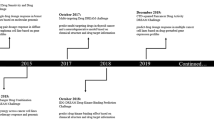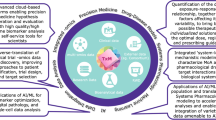Abstract
Neuroimaging has been identified as a potentially powerful probe for the in vivo study of drug effects on the brain with utility across several phases of drug development spanning preclinical and clinical investigations. Specifically, neuroimaging can provide insight into drug penetration and distribution, target engagement, pharmacodynamics, mechanistic action and potential indicators of clinical efficacy. In this review, we focus on machine learning approaches for neuroimaging which enable us to make predictions at the individual level based on the distributed effects across the whole brain. Crucially, these approaches can be trained on data from one study and applied to an independent study and, unlike group-level statistics, can be readily use to assess the generalisability to unseen data. In this review, we present examples and suggestions for how machine learning could help answer fundamental questions spanning the drug discovery pipeline: (1) Who should I recruit for this study? (2) What should I measure and when should I measure it? (3) How does the pharmacological agent behave using an experimental medicine model?, and (4) How does a compound differ from and/or resemble existing compounds? Specifically, we present studies from the literature and we suggest areas for the focus of future development. Further refinement and tailoring of machine learning techniques may help realise their tremendous potential for drug discovery and drug validation.



Similar content being viewed by others
References
Borsook D, Becerra L, Hargreaves R (2006) A role for fMRI in optimizing CNS drug development. Nat Rev Drug Discov 5:411–424
Borsook D, Beccera L, Bullmore E, Hargreaves R (2010) Imaging in CNS drug discovery and development. Springer, New York
Borsook D, Becerra L, Fava M (2013) Use of functional imaging across clinical phases in CNS drug development. Transl Psychiat 3
Bruns A, Kunnecke B, Risterucci C, Moreau JL, von Kienlin M (2009) Validation of cerebral blood perfusion imaging as a modality for quantitative pharmacological MRI in rats. Magnetic Reson Med : Off J Soc Magn Reson Med/ Soc Magn Reson Med 61:1451–8
Bullmore E, Sporns O (2009) Complex brain networks: graph theoretical analysis of structural and functional systems. Nat Rev Neurosci 10:186–98
Burges CJC (1998) A tutorial on support vector machines for pattern recognition. Data Min Knowl Disc 2:121–167
Bymaster FP, Heath I, Hendrix JC, Shannon HE (1993) Comparative behavioral and neurochemical activities of cholinergic antagonists in rats. J Pharmacol Exp Ther 267:16–24
Cherry S (1996) Singular value decomposition analysis and canonical correlation analysis. J Clim 9:2003–2009
Cho W, Maruff P, Connell J, Gargano C, Calder N, Doran S, Fox-Bosetti S, Hassan A, Renger J, Herman G, Lines C, Verma A (2011) Additive effects of a cholinesterase inhibitor and a histamine inverse agonist on scopolamine deficits in humans. Psychopharmacology 218:513–24
Cortes C, Vapnik V (1995) Support-vector networks. Mach Learn 20:273–297
Costafreda SG, Chu C, Ashburner J, Fu CH (2009) Prognostic and diagnostic potential of the structural neuroanatomy of depression. PLoS One 4:e6353
Cuingnet R, Gerardin E, Tessieras J, Auzias G, Lehericy S, Habert MO, Chupin M, Benali H, Colliot O (2011) Automatic classification of patients with Alzheimer’s disease from structural MRI: a comparison of ten methods using the ADNI database. NeuroImage 56:766–81
De Simoni S, Schwarz AJ, O’Daly OD, Stephenson S, Zelaya FO, Williams SCR, Mehta MA (2013) Test-retest reliability of the BOLD pharmacological MRI response to ketamine in healthy volunteers. NeuroImage 64:75–90
Di Santo SG, Prinelli F, Adorni F, Caltagirone C, Musicco M (2013) A meta-analysis of the efficacy of donepezil, rivastigmine, galantamine, and memantine in relation to severity of Alzheimer’s disease. J Alzheimers Dis 35:349–61
Dodds CM, Muller U, Clark L, van Loon A, Cools R, Robbins TW (2008) Methylphenidate has differential effects on blood oxygenation level-dependent signal related to cognitive subprocesses of reversal learning. J Neurosci : Off J Soc Neurosci 28:5976–82
Donaldson ZR, Young LJ (2008) Oxytocin, vasopressin, and the neurogenetics of sociality. Science 322:900–4
Doyle OM, Mehta MA, Brammer MJ, Schwartz AJ, De Simoni S, Marquand AF (2012) Data-driven modeling of BOLD drug response curves using Gaussian process learning. Springer Lecture Notes in Artificial Intelligence: 7263: In Press.
Doyle OM, Ashburner J, Zelaya FO, Williams SC, Mehta MA, Marquand AF (2013a) Multivariate decoding of brain images using ordinal regression. NeuroImage 81C:347–357
Doyle OM, De Simoni S, Schwarz AJ, Brittain C, O’Daly OG, Williams SCR, Mehta MA (2013) Quantifying the attenuation of the ketamine phMRI response in humans: a validation using antipsychotic and glutamatergic agents. . J Pharmacol Exp Ther (In Press)
Doyle OM, Tsaneva-Atansaova K, Harte J, Tiffin PA, Tino P, Diaz-Zuccarini V (2013c) Bridging paradigms: hybrid mechanistic-discriminative predictive models. IEEE Trans Bio-Med Eng 60:735–42
Doyle OM, Westman E, Marquand AF, Mecocci P, Vellas B, Tsolaki M, Kloszewska I, Soininen H, Lovestone S, Williams SC, Simmons A (2014) Predicting progression of Alzheimer’s disease using ordinal regression. PLoS One 9:e105542
Duff EP, Vennart W, Wise RG, Howard MA, Harris RE, Lee M, Wartolowska K, Wanigasekera V, Wilson FJ, Whitlock M, Tracey I, Woolrich MW, Smith SM (2015) Learning to identify CNS drug action and efficacy using multistudy fMRI data. Sci Trans Med 7:274ra16
Figueroa RL, Zeng-Treitler Q, Kandula S, Ngo LH (2012) Predicting sample size required for classification performance. BMC Med Inform Decis Making 12:8
Fu CH, Steiner H, Costafreda SG (2013) Predictive neural biomarkers of clinical response in depression: a meta-analysis of functional and structural neuroimaging studies of pharmacological and psychological therapies. Neurobiol Dis 52:75–83
Gong Q, Wu Q, Scarpazza C, Lui S, Jia Z, Marquand A, Huang X, McGuire P, Mechelli A (2011) Prognostic prediction of therapeutic response in depression using high-field MR imaging. NeuroImage 55:1497–503
Guo Y, Graber A, McBurney RN, Balasubramanian R (2010) Sample size and statistical power considerations in high-dimensionality data settings: a comparative study of classification algorithms. BMC Bioinforma 11:447
Hahn T, Kircher T, Straube B, Wittchen HU, Konrad C, Strohle A, Wittmann A, Pfleiderer B, Reif A, Arolt V, Lueken U (2015) Predicting treatment response to cognitive behavioral therapy in panic disorder with agoraphobia by integrating local neural information. JAMA Psychiatry 72:68–74
Haufe S, Meinecke F, Gorgen K, Dahne S, Haynes JD, Blankertz B, Biessmann F (2014) On the interpretation of weight vectors of linear models in multivariate neuroimaging. NeuroImage 87:96–110
Honey G, Bullmore E (2004) Human pharmacological MRI. Trends Pharmacol Sci 25:366–74
Insel TR (2012) Next-generation treatments for mental disorders. Science translational medicine 4
Insel TR (2014) The NIMH Research Domain Criteria (RDoC) Project: precision medicine for psychiatry. Am J Psychiatry 171:395–7
Joules R, Doyle OM, Schwarz AJ, O’Daly OG, Brammer MJ, Williams SCR, Mehta MA (2015) Ketamine induces a robust whole-brain connectivity pattern that can be differentially modulated by drugs of different mechanism and clinical profile. In submission
Kapur S, Phillips AG, Insel TR (2012) Why has it taken so long for biological psychiatry to develop clinical tests and what to do about it? Mol Psychiatry 17:1174–1179
Kendler KS, Eaves LJ, Walters EE, Neale MC, Heath AC, Kessler RC (1996) The identification and validation of distinct depressive syndromes in a population-based sample of female twins. Arch Gen Psychiatry 53:391–399
Khodayari-Rostamabad A, Hasey GM, Maccrimmon DJ, Reilly JP, de Bruin H (2010) A pilot study to determine whether machine learning methodologies using pre-treatment electroencephalography can predict the symptomatic response to clozapine therapy. Clin Neurophysiol 121:1998–2006
Kriegeskorte N, Lindquist MA, Nichols TE, Poldrack RA, Vul E (2010) Everything you never wanted to know about circular analysis, but were afraid to ask. J Cereb Blood Flow Metab : Off J Int Soc Cereb Blood Flow Metab 30:1551–7
Krystal JH, Karper LP, Seibyl JP, Freeman GK, Delaney R, Bremner JD, Heninger GR, Bowers MB Jr, Charney DS (1994) Subanesthetic effects of the noncompetitive NMDA antagonist, ketamine, in humans. Psychotomimetic, perceptual, cognitive, and neuroendocrine responses. Arch Gen Psychiatry 51:199–214
Lavecchia A (2014) Machine-learning approaches in drug discovery: methods and applications. Drug discovery today
Lenz RA, Baker JD, Locke C, Rueter LE, Mohler EG, Wesnes K, Abi-Saab W, Saltarelli MD (2012) The scopolamine model as a pharmacodynamic marker in early drug development. Psychopharmacology 220:97–107
Liao Q, Wang J, Webster Y, Watson IA (2009) GPU accelerated support vector machines for mining high-throughput screening data. J Chem Inf Model 49:2718–25
Mak IWY, Evaniew N, Ghert M (2014) Lost in translation: animal models and clinical trials in cancer treatment. Am J Transl Res 6:114–118
Marquand AF, O’Daly OG, De Simoni S, Alsop DC, Maguire RP, Williams SC, Zelaya FO, Mehta MA (2012) Dissociable effects of methylphenidate, atomoxetine and placebo on regional cerebral blood flow in healthy volunteers at rest: a multi-class pattern recognition approach. NeuroImage 60:1015–24
Medhi B, Misra S, Avti PK, Kumar P, Kumar H, Singh B (2014) Role of neuroimaging in drug development. Rev Neurosci 25:663–673
Mehta M, O’Daly O (2011) Pharmacological Application of fMRI. In: Modo M, Bulte JWM (eds) Magnetic resonance neuroimaging (methods in molecular biology). Humana Press, pp 551–565
Oquendo MA, Baca-Garcia E, Artes-Rodriguez A, Perez-Cruz F, Galfalvy HC, Blasco-Fontecilla H, Madigan D, Duan N (2012) Machine learning and data mining: strategies for hypothesis generation. Mol Psychiatry 17:956–9
Paloyelis Y, Doyle OM, Zelaya FO, Maltezos S, Williams SC, Fotopoulou A, Howard MA (2014) A spatiotemporal profile of in vivo cerebral blood flow changes following intranasal oxytocin in humans. Biol Psychiatry
Pauls AM, O’Daly OG, Rubia K, Riedel WJ, Williams SC, Mehta MA (2012) Methylphenidate effects on prefrontal functioning during attentional-capture and response inhibition. Biol Psychiatry 72:142–9
Rasmussen CE, Williams CKI (2006) Gaussian processes for machine learning. MIT Press, Cambridge, Mass
Schwarz AJ, Becerra L, Upadhyay J, Anderson J, Baumgartner R, Coimbra A, Evelhoch J, Hargreaves R, Robertson B, Iyengar S, Tauscher J, Bleakman D, Borsook D (2011a) A procedural framework for good imaging practice in pharmacological fMRI studies applied to drug development #1: processes and requirements. Drug Discov Today 16:583–93
Schwarz AJ, Becerra L, Upadhyay J, Anderson J, Baumgartner R, Coimbra A, Evelhoch J, Hargreaves R, Robertson B, Iyengar S, Tauscher J, Bleakman D, Borsook D (2011b) A procedural framework for good imaging practice in pharmacological fMRI studies applied to drug development #2: protocol optimization and best practices. Drug Discov Today 16:671–82
Shawe-Taylor J, Cristianini N (2004) Kernel methods for pattern analysis. Cambridge University Press, Cambridge
Smith SM, Miller KL, Salimi-Khorshidi G, Webster M, Beckmann CF, Nichols TE, Ramsey JD, Woolrich MW (2011) Network modelling methods for FMRI. NeuroImage 54:875–91
Sullivan PF, Kessler RC, Kendler KS (1998) Latent class analysis of lifetime depressive symptoms in the national comorbidity survey. Am J Psychiatry 155:1398–406
Sun LA, Ji SW, Yu SP, Ye JP (2009) On the equivalence between canonical correlation analysis and orthonormalized partial least squares. 21st International Joint Conference on Artificial Intelligence (Ijcai-09), Proceedings: 1230–1235.
Wang DJ, Chen Y, Fernandez-Seara MA, Detre JA (2011) Potentials and challenges for arterial spin labeling in pharmacological magnetic resonance imaging. J Pharmacol Exp Ther 337:359–66
Wise RG, Preston C (2010) What is the value of human FMRI in CNS drug development? Drug Discov Today 15:973–980
Wong DF, Tauscher J, Grunder G (2009) The role of imaging in proof of concept for CNS drug discovery and development. Neuropsychopharmacol 34:187–203
Acknowledgements
OMD gratefully acknowledges support from the EPSRC grant EP/L000296/1. OMD, MAM and MJB gratefully acknowledge support from the Innovative Medicines Initiative Joint Undertaking under Grant Agreement No 115008 (NEWMEDS). The Innovative Medicines Initiative Joint Undertaking is a public-private partnership between the European Union and the European Federation of Pharmaceutical Industries and Associations.
Conflict of interest
Over the past 5 years, Mitul A. Mehta has received research funding from Eli Lilly, Roche and Takeda; has acted as a consultant for Cambridge Cognition and Lundbeck and received fees from Shire for contributions towards education. All others declare no conflicts of interest.
Author information
Authors and Affiliations
Corresponding author
Rights and permissions
About this article
Cite this article
Doyle, O.M., Mehta, M.A. & Brammer, M.J. The role of machine learning in neuroimaging for drug discovery and development. Psychopharmacology 232, 4179–4189 (2015). https://doi.org/10.1007/s00213-015-3968-0
Received:
Accepted:
Published:
Issue Date:
DOI: https://doi.org/10.1007/s00213-015-3968-0




